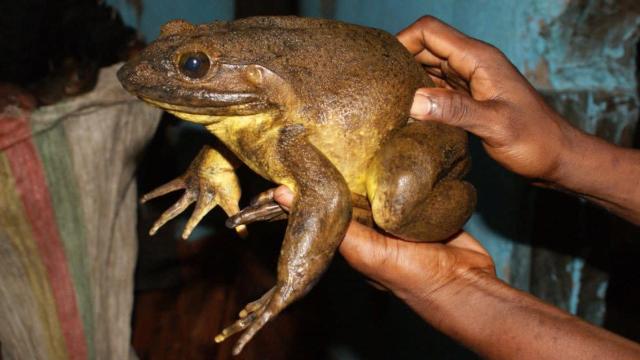New evidence shows that Goliath frogs — the world’s largest species of frog — construct their own ponds, providing a safe space for their tadpoles to grow.
New research published Friday in the Journal of Natural History is the first to provide evidence of pond-building behaviour in an African amphibian, namely the Goliath frog. This is the largest species of frog in the world, weighing upwards of 3.3 kg and measuring 34 centimetres in length, legs not included. The lead authors of the new study, Mark-Oliver Rödel and Marvin Schäfer from the Natural History Museum of Berlin, say the Goliath frogs’ unusually large size could be connected to their distinctive pond-building behaviour.
Using timelapse camera traps, the researchers collected evidence of the Goliath frogs building their ponds — efforts that sometimes required them to move rocks weighing over 4.4 pounds (2 kg).
“Goliath frogs are not only huge, but our discovery shows they seem to be attentive parents as well,” said Schäfer in a press release. “The little ponds they make at the edges of fast-flowing rivers provide their eggs and tadpoles with a safe haven from sometimes torrential waters, as well as from the many predators living there. We think that the heavy work they put into excavation and moving rocks may explain why gigantism evolved in these frogs in the first place.”
Scientists have observed nest-building behaviours in frogs before, but nothing on the scale of constructing personalised aquatic nurseries. For instance, “some South American species dig holes into which they deposit their eggs,” Rödel told Gizmodo. “In most of these cases the tadpoles remain in a mass of foam created by the parents.” The only other species that does anything remotely similar to the Goliaths, he explained, is the South African bullfrog, which digs a channel to another pond to prevent the pool from drying out.
“Amphibians — frogs in particular — have numerous and absolutely fascinating reproductive strategies,” said Rödel. “The Goliath story represents just one of them, but this was completely unexpected as no other African frog does this [the pond-building behaviour] and the relatives of the Goliaths are not known to [participate in] parental care.”
Goliath frogs are only found in Cameroon and Equatorial Guinea, and they’re dependent on fast-flowing streams in rainforest environments. Interestingly, the group of frogs to which Goliaths belong feature a distinctive calling behaviour. Instead of using vocal sacs like other frogs, they whistle with their mouths open.
“It sounds like the song of a bird!” said Rödel.
While conducting unrelated research into Goliath frogs, Schäfer and Rödel heard stories from local trappers, who consume frogs as bushmeat, about the unusual breeding behaviour of Goliaths. The team decided to investigate further.
“The frogs are unfortunately very skittish,” Rödel told Gizmodo. “Thus it is very difficult to observe them. Hence we had to collect mainly indirect evidence.”
While scouring the banks of the Mpoula River in Equatorial Guinea, the scientists initially found batches of eggs and tadpoles. With persistence and keen eyes, the duo eventually spotted materials dug up by the Goliath frogs. This material, which included bits of leaves, gravel, and other debris, was piled up in a way that wasn’t consistent with other natural processes, such as the effects of river currents.
Equipped with the knowledge of what they were now looking for, the researchers walked repeatedly along the banks of the river, searching for similar structures and taking careful notes of all the frog-built ponds they could find. In total, the researchers managed to document 22 breeding sites, of which 14 contained at least 3000 eggs.
A big payoff came when the researchers set up the camera traps. These cameras didn’t actually catch the frogs in the act of digging or clearing their nests, but photographs taken over the course of several days chronicled their progress—from the first digging efforts to the depositing of eggs.
“It’s simply unbelievable that a frog — which is so famous — shows such a unique behaviour, and that this hasn’t been published before,” said Rödel.
Some DIY ponds were very simple, involving the removal of debris, such as leaves, small sticks, and gravel, from small pools. More complex ponds involved the frogs pushing debris to the top of shallow pools, creating an artificial dam (see image above and below).
But the most impressive structures involved the removal of stones from small pits in shallow water, resulting in a circular pond. This proved to be the best design, making the eggs were less susceptible to getting washed out by heavy rain. The researchers weren’t able to determine if males or females (or both) built these ponds, or who did the guarding.
Rödel said there’s likely a connection between the size of Goliath frogs and the nest-building behaviour.
“That is what we believe,” he told Gizmodo. “In order to build these nests and move pebbles and even large stones, the frog needs to be strong… it seems very likely that the breeding behaviour of the Goliaths is a reason for their extraordinary size.”
The new research, said Rödel, shows how much we still don’t know about the natural world, and what we imminently risk losing. Sadly, Goliath frogs are listed as an endangered species, with their numbers dropping by half over the past decade. Around one-third of all amphibian species “are threatened with extinction” he said, and by losing them “we would also lose their unique behaviours, their role in ecosystems, and all the things they could potentially show us,” such as peptides from frogs to combat HIV and other frog substances used to treat disease.
To which he added: “If we know so little about Goliaths, what else is out there what we may never detect?”
